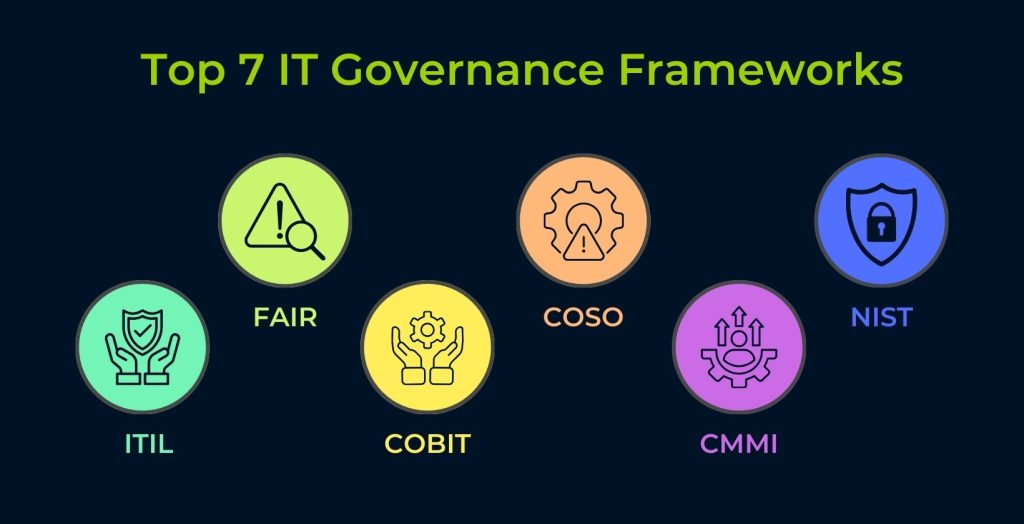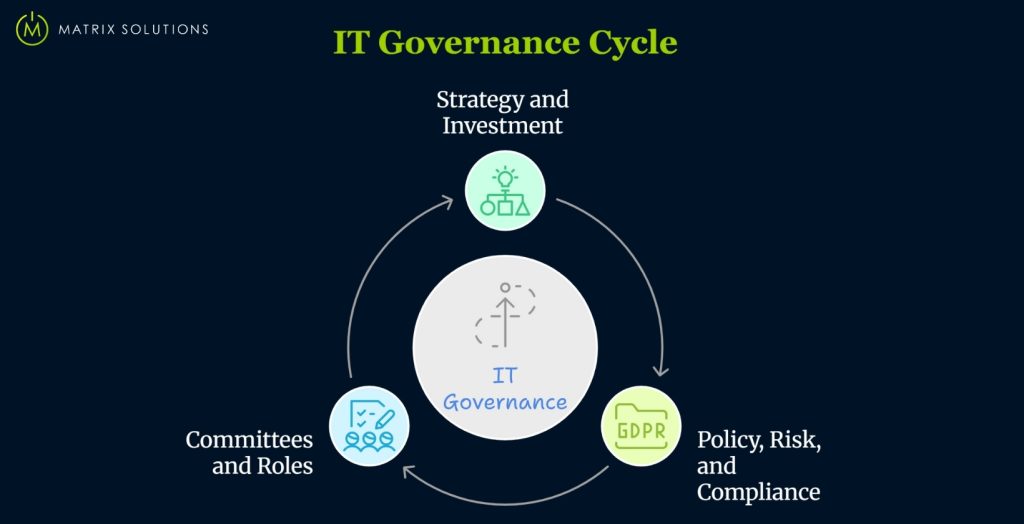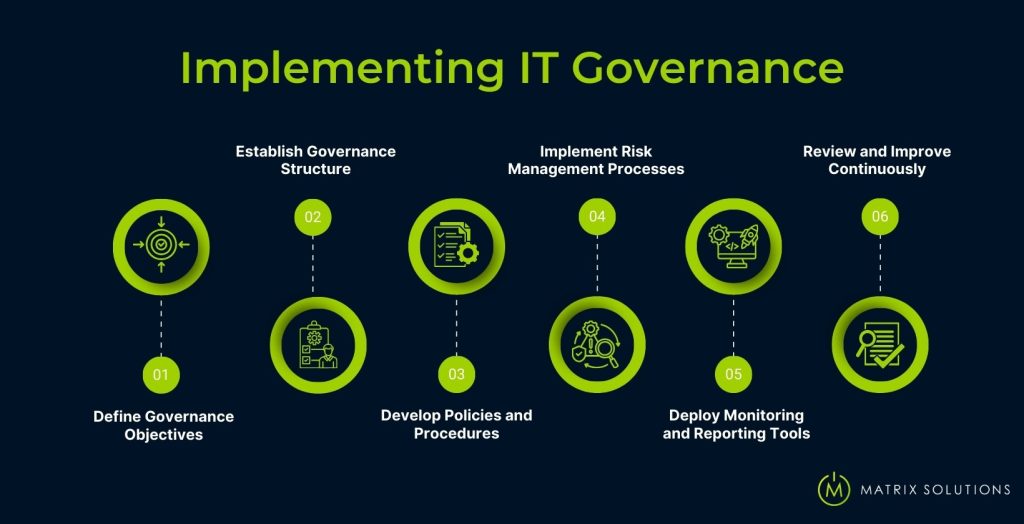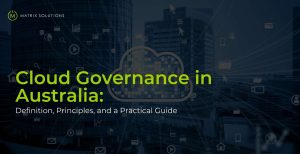As technology drives business growth, aligning IT operations with organisational goals has become a boardroom priority. Organisations face increasing pressure to meet regulatory requirements, secure digital assets, and demonstrate measurable returns on IT investments. Without a structured approach, even funded initiatives increase the risk of failure or exposure to cyber and operational threats.
IT governance frameworks introduce the structure, transparency, and oversight required to manage performance, reduce risk, and ensure compliance. In this guide, we explore the top 7 IT governance frameworks, explain their core principles, and show how to select the right model for your organisation.
What is IT Governance?
IT governance is a decision-making framework that ensures IT investments support business goals, manage risks, and deliver value through accountability.
Unlike corporate governance, which focuses on the overall direction and ethical oversight of an organisation, IT governance specifically aligns technology decisions with strategic outcomes.
Unlike IT management, which handles day-to-day operations, IT governance defines who holds decision rights and how those rights are exercised.
At its core, IT governance establishes accountability structures, performance metrics, and role clarity to guide IT decision-making and ensure value delivery.
Top 7 IT Governance Frameworks (2025 Comparison)
Choosing the right IT governance framework depends on your organisation’s size, goals, and risk profile. Each framework supports a different set of objectives, from enterprise-wide oversight to cybersecurity risk management.
Below is a 2025 side-by-side comparison of the top 7 IT governance frameworks, ranked by adoption and business alignment criteria.
Framework | Core Focus | Best For | Governance Scope |
COBIT | Control, audit, and performance | Enterprise-wide IT oversight | Decision-making, accountability, value delivery |
ITIL | Service management and delivery | IT operations and service desks | Process optimisation, continuous improvement |
ISO/IEC 38500 | Governance principles and accountability | Board-level IT strategy | Policy, responsibility, leadership alignment |
ISO/IEC 27001 | Information security management | Risk-sensitive or regulated sectors | Data protection, compliance, risk controls |
TOGAF | Enterprise architecture | Large-scale IT planning | Strategic alignment, architecture governance |
CMMI | Process maturity and optimisation | Organisations seeking quality assurance | Capability benchmarking, performance improvement |
NIST CSF | Cybersecurity framework | Critical infrastructure and digital assets | Identify, protect, detect, respond, and recover |
1. COBIT (Control Objectives for Information and Related Technologies)
COBIT is a widely adopted IT governance framework used by enterprises, auditors, and regulators to align IT strategy with business goals. It structures governance across five domains, including evaluation, direction, and monitoring, and offers detailed process controls, performance metrics, and maturity models.
The framework is especially relevant in regulated sectors such as finance, law, and healthcare, where accountability and compliance are tightly enforced. COBIT promotes strategic alignment and consistent decision-making.
2. ITIL (Information Technology Infrastructure Library)
ITIL is an IT governance framework centred on IT service management (ITSM), helping organisations deliver reliable, value-driven IT services. ITIL v4 introduces practices like incident management, change control, and continual improvement within a flexible service-value system.
Its lifecycle-based approach, covering strategy, design, transition, operation, and improvement, ensures governance is embedded across all service stages. It is frequently adopted by MSPs, internal IT departments, and customer-facing support teams.
3. ISO/IEC 38500
ISO/IEC 38500 is a global IT governance standard that guides boards and executives in overseeing the effective use of IT. It defines six core principles: responsibility, strategy, acquisition, performance, conformance, and human behaviour.
ISO/IEC 38500 is often favoured by smaller firms or organisations starting formal governance, as it focuses on board-level clarity rather than prescribing complex processes. The standard enhances ethical oversight and long-term IT strategy.
4. ISO/IEC 27001
ISO/IEC 27001 is the leading international standard for information security governance, focusing on establishing and enhancing an Information Security Management System (ISMS). Its core clauses, such as risk assessment, leadership, support, operation, and performance evaluation, offer a structured way to protect data assets.
Integrated into broader IT governance, it ensures security controls align with business goals and compliance demands. It’s essential for organisations prioritising data protection and risk management, including those in the legal, banking, and healthcare sectors.

5. TOGAF (Enterprise Architecture)
TOGAF (The Open Group Architecture Framework) is an enterprise architecture-based IT governance framework that helps organisations align technology systems with business goals. Its core method, the Architecture Development Method (ADM), structures governance through phases like vision, planning, migration, and implementation.
TOGAF is widely used in digital transformation and enterprise redesign projects, where architecture strategy must guide operational changes. It’s ideal for enterprises formalising governance through consistency and lifecycle control.
6. CMMI (Process Maturity)
CMMI (Capability Maturity Model Integration) is a process-focused framework that helps organisations improve the maturity of practices across domains such as development, services, and acquisition. It offers two models: staged (levels 1 to 5) and continuous (targeted by capability area).
CMMI is often implemented by engineering teams, compliance units, and IT audit departments to increase operational discipline. In IT governance, it reinforces structure through measurable performance and quality metrics.
7. NIST Cybersecurity Framework (CSF)
NIST CSF is a risk-based framework that helps organisations manage and reduce cybersecurity threats. Its five core functions, Identify, Protect, Detect, Respond, and Recover, provide a structured approach to assessing and improving security posture. By integrating these functions into governance processes, CSF promotes accountability, resilience, and regulatory alignment.
It’s widely adopted by public agencies, law firms, and cloud-based businesses, particularly those managing sensitive or regulated data. NIST CSF ensures that cyber risk is integrated into broader IT governance models.
Why is IT Governance Important?
IT governance is important because it ensures technology decisions support business goals, manage risks, and deliver measurable value with accountability.
Strong governance reduces exposure to operational, cyber, and financial risks by defining who makes decisions, how controls are applied, and how incidents are managed. This is essential in fast-changing digital environments, especially for firms in regulated sectors.
Frameworks such as ISO 27001 and NIST CSF help organisations meet compliance obligations, avoid penalties, and maintain accountability across systems and data use.
Effective IT governance frameworks enhance transparency and performance by enabling stakeholders to measure outcomes, justify IT investments, and improve operations confidently over time.
Principles of Effective IT Governance
Effective IT governance rests on four core principles: strategic alignment, risk management, performance measurement, and resource accountability. These principles help organisations apply frameworks effectively by aligning IT decisions with business goals, operational needs, and stakeholder expectations.

1. Accountability
Accountability in IT governance means assigning clear decision rights and defining who is responsible for each outcome. When responsibilities are visible across leadership and technical teams, execution is faster and risks are reduced. Defined accountability ensures that key IT decisions are assigned to the right individuals at the appropriate time.
2. Transparency
Transparency in IT governance means openly communicating performance metrics, risks, and decisions across stakeholders. Dashboards, reporting, and audit trails give leadership visibility into how IT performs and where improvements are needed. This openness builds trust, supports compliance, and enables faster course corrections.
3. Value Delivery
Value delivery in IT governance entails ensuring that IT services and projects directly contribute to business outcomes. This includes aligning technology initiatives with strategic goals, measuring return on investment (ROI), and tracking benefits through key performance indicators (KPIs). When value is clearly demonstrated, IT becomes a growth enabler, not a cost centre.
4. Risk Optimisation
Risk optimisation in IT governance means balancing innovation and control to protect the organisation while enabling change. It involves maintaining up-to-date risk registers, embedding controls into workflows, and ensuring risk management is proactive. When risk is handled strategically, IT becomes more resilient and better aligned with business growth.
Key IT Governance Domains & Structures
IT governance domains define the operational areas where decisions, controls, and accountability are applied to align IT with business strategy.

Strategy and Investment
The strategy and investment domain focuses on aligning IT initiatives with business goals through disciplined planning and portfolio management. This includes evaluating project value, prioritising investments, and ensuring IT budgets are allocated to maximise ROI. It supports long-term outcomes by linking technology spending to strategic impact.
Policy, Risk, and Compliance
The policy, risk, and compliance domain governs how organisations develop policies, assess threats, and meet legal obligations. Regular risk assessments and the implementation of controls help reduce exposure, while compliance frameworks such as ISO or NIST ensure adherence. This domain is especially relevant in regulated industries such as legal or finance.
Committees and Roles
Committees and roles establish decision-making responsibilities within the IT governance structure. Steering committees, IT councils, and executive stakeholders ensure that policy enforcement and strategic alignment are consistently managed. Defined roles, such as CIO, CTO, or risk officer, support clarity, authority, and accountability.
Step-by-Step IT Governance Implementation Guide
An IT governance implementation guide provides a structured sequence for aligning governance practices with business goals and risk controls. Implementing an effective IT governance framework requires a clear, structured approach to ensure alignment, accountability, and measurable results. Follow these six essential steps for successful IT governance implementation:

1. Define Governance Objectives
Owner: CIO or IT Governance Lead
Deliverable: Documented governance goals aligned with business strategy
Success Metric: Stakeholder approval and clarity on governance scope
2. Establish Governance Structure
Owner: IT Leadership Team
Deliverable: Defined committees, roles, and responsibilities
Success Metric: Formal governance charter ratified by executives
3. Develop Policies and Procedures
Owner: Risk and Compliance Officer
Deliverable: Comprehensive IT governance policies and control procedures
Success Metric: Policy adoption rate and audit readiness
4. Implement Risk Management Processes
Owner: Risk Manager
Deliverable: Risk register and mitigation plans integrated into governance
Success Metric: Reduction in identified IT risks over time
5. Deploy Monitoring and Reporting Tools
Owner: IT Operations Manager
Deliverable: Dashboards and reports for governance KPIs and compliance
Success Metric: Real-time visibility and timely issue escalation
6. Review and Improve Continuously
Owner: IT Governance Committee
Deliverable: Periodic governance reviews and improvement plans
Success Metric: Documented improvements and increased stakeholder satisfaction
This step-by-step guide ensures a solid IT governance control framework implementation toolkit that drives business value and regulatory compliance.
Scaling & Evolving Your IT Governance Model
Scaling and evolving your IT governance model ensures it remains effective as your technology, risk profile, and organisational needs grow. Effective IT governance requires continuous improvement to stay aligned with evolving technology and business needs. Integrating AI and cloud standards into your governance model enhances compliance, mitigates risk, and optimises resource utilisation. Flexible policies help maintain relevance and enable responsible innovation.
Linking governance with architecture and security layers creates a scalable strategy that improves visibility, enforces control consistency, and strengthens security over time.
How to Choose the Right IT Governance Framework
Choosing the right IT governance framework depends on your organisation’s goals, scale, compliance needs, and current governance maturity. Use this checklist to assess which model aligns best with your environment and business priorities:
Fit for Purpose: Start by identifying your primary governance focus: security, service delivery, compliance, or enterprise architecture. For example, a fintech startup may prioritise ISO/IEC 27001 for security compliance, while a public agency may choose NIST CSF for regulatory alignment.
Organisational Scope: Evaluate whether the framework fits your operational size and complexity. COBIT provides enterprise-wide governance with performance metrics. ITIL is well-suited for IT service environments that require consistency and quality in service delivery.
Governance Maturity: Consider how ready your organisation is to adopt formal IT governance. Early-stage teams may prefer lightweight options, such as ITIL or ISO/IEC 38500. Mature enterprises can adopt COBIT or TOGAF to support layered control, architecture integration, and audit requirements.
Which IT Governance Framework Fits Your Business Best?
The best IT governance framework for your business depends on your industry, regulatory environment, and existing IT capabilities. Use real-world scenarios to inform your selection, aligning it with strategic needs and compliance priorities.
Security-Focused Firms
A financial services firm concerned with data protection may adopt ISO/IEC 27001 for its structured controls and audit readiness.
Government or Regulated Agencies
A public-sector agency with federal mandates may implement the NIST Cybersecurity Framework, which provides clear risk functions and alignment with compliance requirements.
Growing Tech Companies
A fast-scaling SaaS company may choose COBIT or ITIL, which offer scalable governance models to support agility and service quality.
How to Roll Out an IT Governance Framework Smoothly
Rolling out an IT governance framework requires strong change management, clear communication, and early stakeholder engagement. This ensures consistent adoption, reduces friction, and accelerates value realisation across the organisation.
Start with quick wins: Launch low-risk, high-impact initiatives such as policy templates or KPI dashboards to build momentum and demonstrate early value.
Engage key stakeholders early: Involve IT, risk, and business leaders in planning to create shared ownership and alignment from the beginning.
Communicate early and often: Use workshops, internal portals, and executive briefings to explain roles, timelines, and the benefits of governance.
IT Governance Auditing: Best Practices
IT governance auditing ensures that governance structures are effective, compliant, and continuously improving. Audits identify control gaps, track performance, and validate that policies are being followed as intended.
- Internal Audits: Focus on policy adherence, role execution, and process effectiveness. These audits help identify weaknesses and improve internal accountability.
- External Audits: Assess regulatory compliance, data security, and third-party risk. External reviews provide independent assurance and support certifications like ISO or SOC.
📍Key KPIs: Policy violation rates, audit resolution times, and risk remediation progress.
Frequently Asked Questions
What are the benefits of an IT governance framework?
The benefits of an IT governance framework include clear accountability, reduced risk, improved compliance, and stronger alignment between IT and business strategy. Frameworks also help measure performance and justify IT investments.
How is IT governance different from IT management?
IT governance is different from IT management because governance defines what decisions must be made and who makes them, while management focuses on how those decisions are executed. Governance sets direction; management handles implementation.
How long does it take to roll out an IT governance program?
Rolling out an IT governance program takes 3–6 months for basic setups. Complex governance programs with multiple stakeholders, policies, and integration can take 12 months or more, depending on size and readiness.
Which IT framework is best for small businesses?
The best IT governance framework for small businesses is typically ISO/IEC 38500 or ITIL, as both are lightweight and scalable. COBIT can work if simplified for smaller teams with limited governance maturity.
Is certification required to implement COBIT or ITIL?
No, certification is not required to implement COBIT or ITIL. Organisations can adopt the frameworks without formal credentials, though training improves internal adoption and audit readiness.
Wrapping Up Your IT Governance Journey
Strong IT governance frameworks help organisations align technology with business goals, reduce risk, and improve accountability across systems and decisions. From COBIT and ITIL to NIST and CMMI, each model supports a different aspect of governance, whether it’s compliance, value delivery, architecture, or maturity. Knowing how to assess, implement, and adapt these models is critical to long-term success.
Whether you’re just starting fresh or refining an existing governance model, focus on continuous improvement, cross-functional visibility, and stakeholder alignment.
Ready to operationalise your strategy?
Build a roadmap, secure leadership buy-in, and select the framework that fits with support from trusted IT partners like Matrix Solutions.
Get Your Free Consultation!



